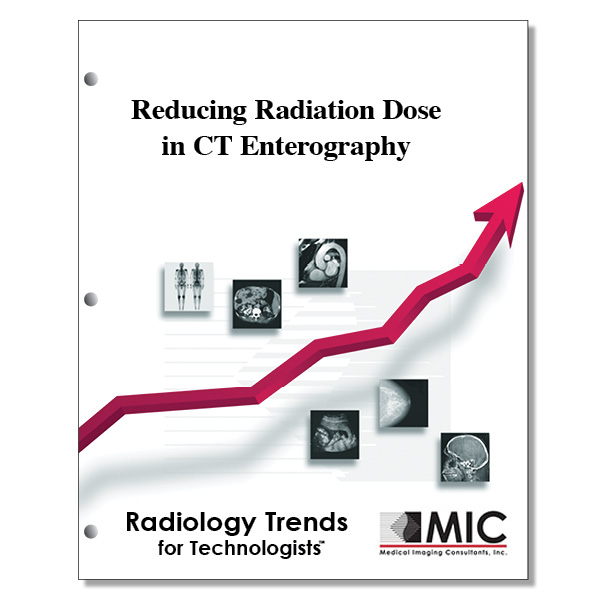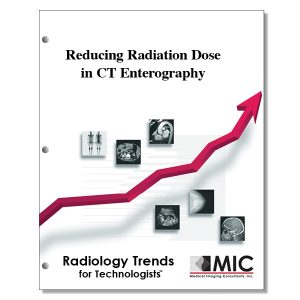

Reducing Radiation Dose in CT Enterography
Standard CT enterography is described and dose-reduction strategies are presented.
Course ID: Q00397 Category: Radiology Trends for Technologists Modality: CT2.75 |
Satisfaction Guarantee |
$29.00
- Targeted CE
- Outline
- Objectives
Targeted CE per ARRT’s Discipline, Category, and Subcategory classification for enrollments starting after August 22, 2024:
[Note: Discipline-specific Targeted CE credits may be less than the total Category A credits approved for this course.]
Computed Tomography: 2.75
Safety: 2.00
Radiation Safety and Dose: 2.00
Image Production: 0.50
Image Formation: 0.25
Image Evaluation and Archiving: 0.25
Procedures: 0.25
Abdomen and Pelvis: 0.25
Registered Radiologist Assistant: 2.25
Safety: 2.00
Patient Safety, Radiation Protection, and Equipment Operation: 2.00
Procedures: 0.25
Abdominal Section: 0.25
Outline
- Introduction
- Standard CT Enterographic Techniques
- Quantifying CT Radiation Dose
- Low-Dose CT Enterography
- Scan Coverage
- Tube Potential
- Tube Current
- Tube Current Modulation and Automatic Exposure Control
- Patient Size Modulation
- Z-Axis Modulation
- XñY-axis (Angular) Modulation
- Synergy of Kilovoltage Selection, Tube Current Modulation, and Size Adaptation
- Noise-Reduction Methods and Iterative Techniques
- Comparison of Denoising Techniques
- True Iterative Reconstruction: MBIR and Iterative Reconstruction Prototypes
- Iterative Noise-Reduction Methods: ASIR and SAFIRE
- Image Space Denoising
- Projection Space Denoising
- Synergy of Denoising Methods
- Comparison of Denoising Techniques
- Challenges of Low-Dose CT Enterography
- Conclusion
Objectives
Upon completion of this course, students will:
- be familiar with the purpose for evaluating patients with CT enterography
- identify the strategies for reducing radiation dose at CT enterography
- be familiar with the advantages of CT enterography
- be familiar with the most common indication for performing CT enterography
- identify the patient symptoms related to Crohn disease
- be familiar with the number of CT acquisitions to evaluate GI bleeding
- be familiar with the volume of oral contrast administered for CT enterography
- identify the rate of i.v. contrast administration recommended for CT enterography
- be familiar with the acronym CTDI
- understand how the CTDI is measured at axial scanning
- be familiar with the international system of units for CTDIvol
- be able to identify what the CTDI measures
- understand how the DLP is calculated
- be familiar with the increase in radiation dose during standard triphasic CT enterography
- be familiar with excluded unwanted anatomy to reduce radiation dose in CT enterography
- understand how to properly adjust kVp related to patient size
- identify the types of CT automatic exposure controls
- be familiar with the increase of radiation exposure to the U.S. population
- identify the current campaigns to reduce radiation exposure
- be familiar with the development of CTDI
- understand how the CTDIvol is calculated
- identify the CT dose descriptors most commonly used in the U.S.
- be familiar with the dimensions of the standard CT dosimetry phantoms
- understand which factors affect the radiation dose to a patient during CT
- be familiar with the effect of reducing radiation dose on CT image noise
- identify the historically most common analytic algorithm for reconstructing CT images
- be familiar with the physical effects being incorporated during iterative reconstruction
- identify the primary disadvantage of using iterative reconstruction
- be able to identify CT noise reduction methods
- be familiar with the way different iterative reconstruction processes work
- identify the filters used when using image space denoising
- be familiar with the factors that can affect CT spatial resolution
- be familiar with the history of image reconstruction
- understand the definition of CT artifact
- identify image artifacts that can be experienced in CT
